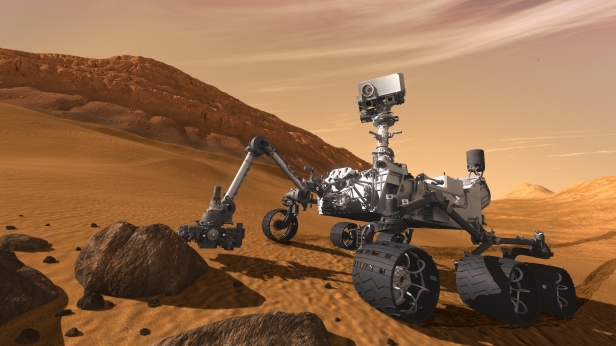 |
Curiosity is the largest and most capable rover ever sent to Mars. It launched November 26, 2011 and landed on Mars at 10:32 p.m. PDT on Aug. 5, 2012 (1:32 a.m. EDT on Aug. 6, 2012).
The Curiosity rover, NASA’s pickup truck sized robot on the Red Planet, has been poking around our closest neighbor’s surface since it’s arrival in August of 2012. The robot was tasked with a specific set of mission objectives: assess the climate and geology of the Gale Crater that it landed in. Its purpose is perhaps the most noble of all outbound space craft: the search for signs of life elsewhere in the universe.
Gale Crater
Curiosity explores Gale Crater and acquires rock, soil, and air samples
for onboard analysis. The car-size rover is about as tall as a
basketball player and uses a 7 foot-long arm to place tools close to
rocks selected for study. Curiosity's large size allows it to carry an
advanced kit of 10 science instruments. It has tools including 17
cameras, a laser to vaporize and study small pinpoint spots of rocks at a
distance, and a drill to collect powdered rock samples. It hunts for
special rocks that formed in water and/or have signs of organics.
Huge Step To Mars Exploration
It is fit to climb over knee-high obstacles and travels about 100 feet (30 meters) per hour, depending on instrument activity, the terrain, and visibility its cameras have of the path ahead. The rover carries a radioisotope power system that generates electricity from the heat of plutonium's radioactive decay. This electrical power source has already far exceeded its required operating lifespan on Mars' surface of at least one full Martian year (687 Earth days). The generator provides greater mobility and flexibility in operating the rover regardless of season or sunlight. The steady flow of electrical power has enhanced the science payload capability and permitted consideration of landing sites at a greater range of latitudes than was possible on previous rovers.It also has following in built features and advanced in such a way that it made is transportation in Red Planet smooth that
- the ability to land a very large, heavy rover to the surface of Mars
- the ability to land more precisely in a 12.4-mile (20-kilometer) landing area
- long-range mobility on Mars for studying diverse environments and analyzing samples found in different settings.
Curiosity's scientific tools found chemical and mineral evidence of
past habitable environments on Mars. It continues to explore the rock
record from a time when Mars could have been home to microbial life.
Launch Machinery
When mission planners are considering different launch models ,they have there center point that how much mass each launch vehicles can lift in space.
Launch Complex 41 at Cape Canaveral Air Force
Station, Fla. The vehicle was provided by United Launch Alliance, a
joint venture of Boeing Co. and Lockheed Martin Corp.
The Atlas V-541 vehicle was selected for the Mars Science Laboratory
mission because it has the right liftoff capability for the heavy weight
requirements and rockets in the same family have successfully lifted
NASA's Mars Reconnaissance Orbiter and New Horizons missions.
Details on the Launch Vehicle
Atlas V rockets are expendable launch vehicles (ELVs), which means
they are only used once. The three numbers in the 541 designation
signify a payload fairing, or nose cone, that is 16.4 feet
(approximately 5 meters) in diameter; four solid-rocket boosters
fastened alongside the central common core booster; and a one-engine
Centaur upper stage.
The major elements of the Atlas V-541 rocket that were used for mission are:
 |
Stage 1: Atlas V Rocket: Fuel and oxygen tanks that feed an engine for the ascent; powers spacecraft into Earth orbit. |
 |
Solid Rocket Motors: Used to increase engine thrust; 4 total. |
 |
Stage 2: Centaur: Fuel and oxidizer and the vehicle's "brains"; fires twice, once to insert the vehicle-spacecraft stack into low Earth orbit and then again to accelerate the spacecraft out of Earth orbit and on its way towards Mars. |
 |
Payload Fairing Thin composite or nose cone to protect the spacecraft during the ascent through Earth's atmosphere. |


0 Comments